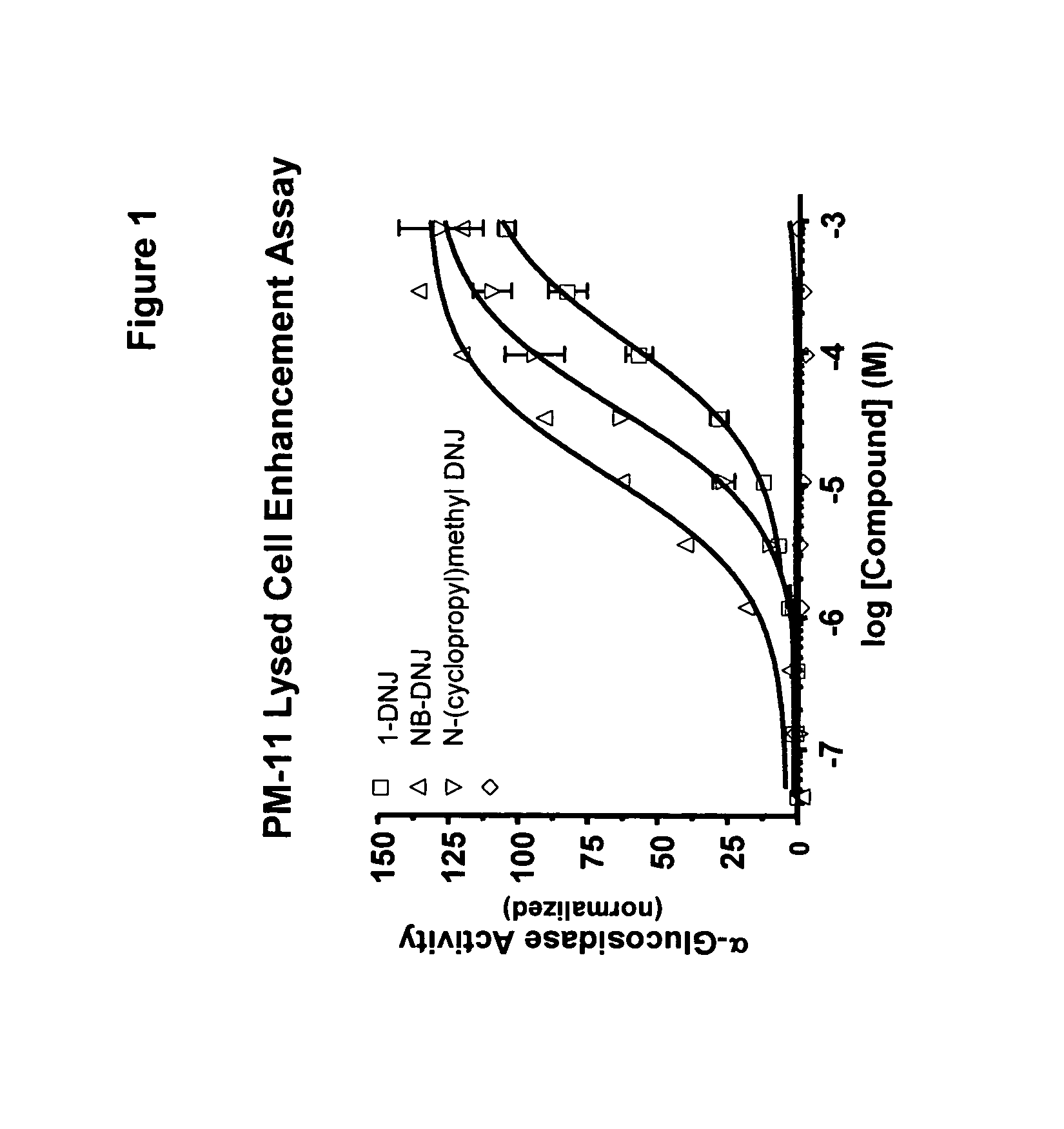Method for the treatment of pompe disease using 1-deoxynojirimycin and derivatives
a technology of pompe disease and deoxynojirimycin, which is applied in the direction of drug compositions, peptide/protein ingredients, metabolic disorders, etc., can solve the problems of no approved treatment for the underlying genetic defect, tongue protrusion and enlargement, and difficulty in swallowing, etc., to relieve or reduce the symptom of pompe disease
- Summary
- Abstract
- Description
- Claims
- Application Information
AI Technical Summary
Benefits of technology
Problems solved by technology
Method used
Image
Examples
example 1
Synthesis of DNJ and Derivatives
Tetra-O-benzyl-1-Deoxynorjirimycin [GENERAL IMINOSUGAR PREP-1]
[0216]
[0217]A solution of DMSO (4.4 mL, 0.124 mol) in dry CH2Cl2 (75 mL) is placed under an Argon atmosphere and cooled to −78° C. A solution of trifluoroacetic anhydride (6.1 mL, 0.088 mol) in dry CH2Cl2 (50 mL) is slowly added maintaining the temperature at −78° C. After the addition is complete, the reaction is stirred an additional 30 minutes, A solution of 2,3,4,6-Tetra-O-benzylglucitol (5.4 g, 10 mmol) in CH2Cl2 is added dropwise. Reaction is stirred at −78° C. for 90 minutes and then quenched by the addition of triethylamine (11.2 mL, 0.08 mol) in CH2Cl2 (50 mL). The reaction is warmed to 0° C. and is then concentrated using a rotovap. The residue is diluted with MeOH (75 mL) and a solution of 2M NH3 in MeOH (10.0 mL, 20.0 mmol) is added followed by formic acid (0.77 mL, 20.0 mmol), 3 Å molecular sieves and finally NaCNBH3 (1.57 g, 25.0 mmol). The mixture is stirred overnight at room...
example 2
Enhancement of Gaa with DNJ and DNJ Derivatives
[0272]Experiments described below indicate that DNJ and DNJ derivative N-butyl-DNJ, known inhibitors of enzymes responsible for glycolipid synthesis, also can bind to and enhance the activity of mutant Gaa without inhibiting glycolipid synthesis.
Methods
[0273]Cell Culture and Seeding.
[0274]The PM11 (P545L), PM8 and PM12 (both slicing defect), fibroblast cell lines was used for enhancement experiments. These cells are fibroblasts isolated from a Pompe patient. Cells were seeded at about 5000 cells per well in 180 μL media in sterile black clear-bottom 96 well Costar plates and incubated for about 3-6 hours at 37° C. with 5% CO2. Media consisted of DMEM with 10% FBS and 1% penicillin / streptomycin.
[0275]Drug Treatment.
[0276]All test compounds are dissolved in 1:1 DMSO:H2O to a stock concentration of 100 mM. Serial dilutions of the cells using another sterile black clear-bottom Costar plate were performed as follows:
[0277]1. 20 μL L of 1:1 D...
example 3
In Vivo Gaa Activity Upon Treatment with DNJ and DNJ Derivatives
[0295]Drug administration. This Example provides information on the effects of DNJ derivatives on mice. The DNJ derivative test compounds were administered to the mice at 0, 1 mg / kg / day; 10 mg / kg / day; and 100 mg / kg / day; organs and plasma were collected at 2 and 4 weeks after initiation of the study. Twenty male C57BL6 (25 g) mice per group were used. The drug was given in the drinking water, therefore water consumption was monitored daily.
[0296]In the control group (0 mg / kg / day), the mice were dosed daily in the drinking water (no drug) and divided into two groups. Ten animals were euthanized after 2 weeks of treatment, blood was collected from the descending aorta or vena cava, and tissues were harvested and then necroposied. After 4 weeks of treatment, the remaining 10 animals were euthanized, and subjected to the same evaluation.
[0297]In the first test group, 20 mice were dosed daily in the drinking water with an adm...
PUM
| Property | Measurement | Unit |
|---|---|---|
| temperature | aaaaa | aaaaa |
| pressure | aaaaa | aaaaa |
| temperature | aaaaa | aaaaa |
Abstract
Description
Claims
Application Information
 Login to View More
Login to View More - R&D
- Intellectual Property
- Life Sciences
- Materials
- Tech Scout
- Unparalleled Data Quality
- Higher Quality Content
- 60% Fewer Hallucinations
Browse by: Latest US Patents, China's latest patents, Technical Efficacy Thesaurus, Application Domain, Technology Topic, Popular Technical Reports.
© 2025 PatSnap. All rights reserved.Legal|Privacy policy|Modern Slavery Act Transparency Statement|Sitemap|About US| Contact US: help@patsnap.com



